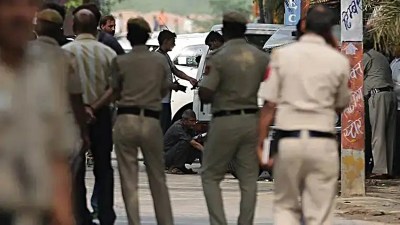Chipping off the old blocks
The new canopies at the Sanghi Ji temple have been built with Dholpur red sandstone, and resemble the several tourist resorts dotting the...

The new canopies at the Sanghi Ji temple have been built with Dholpur red sandstone, and resemble the several tourist resorts dotting the highways leading to Jaipur
A face-lift can do wonders to one’s appearance, but the exercise can also leave behind ugly scars. It’s happening in Sanghi Ji, a 1,000-year-old Digambar Jain temple at Sanganer near Jaipur, thanks to an ambitious “restoration programme” undertaken by the temple management.
Ever since the programme was launched, the ancient temple has lost two of the dozen domes flanking the main dome. Though a section of the Jain community has opposed the move, the temple management is gearing up to remove the rest of the domes as well.
The new canopies that have replaced these domes are in stark contrast with the original white marble, which had acquired a tinge of green over centuries. The new canopies have been built with the Dholpur red sandstone, and resemble the several tourist resorts dotting the highways leading to Jaipur. An entire new storey, named Chaubisi, has been added to the rooftop, without calculating if the structure would be able to take its weight.
This is no isolated case: A centuries-old temple at Nasia nearby, also under the control of the same management, has been razed to the ground. A 450-year-old Jain temple at Nindad Bainad, 20 km from Jaipur, too met a similar fate.
Sanghi Ji, a specimen of the oldest Jain temple architectural traditions, dates back to the tenth century. The presiding deity is Adinath and the temple management claims that the idol is 4,000 years old. An underground chamber houses a collection of idols of Jain Tirthankars, and only a Digambar Muni can bring the idols overground for public viewing. These idols were last brought overground in June 1994 by Muni Sudhasagar, who inspired the temple management to take up “restoration” work and remove “certain flaws” according to Vastushastra.
Muni Sudhasagar visited the temple again and presided over the consecration ceremonies of the Chaubisi between June 20 and 24, 1999. A group of prominent Jains, led by Rajasthan Lokayukt Milap Chand Jain, at a meeting in Jaipur on November 5 expressed their concern over the alterations made to the temple. They decried the “indiscriminate tampering with the original architecture of various Jain temples in the name of restoration.” Jain, who headed the commission of inquiry into the assassination of Rajiv Gandhi, observed that ancient temples, their architecture and idols were priceless treasures. Those present at the meeting included retired Supreme Court judge N.M. Kasliwal, state Director-General of Police (Civil Defence) Vijay Hansuka and IAS officer Ashok Jain. The participants have now decided to set up a front to resist attempts to tamper with temple heritage, and has nominated journalist Milap Chand Dandia as its convenor.
Dandia claimed that some idols, which were chemically treated to give them a ew look, had actually suffered damage in the process as some inscriptions were chipped off. “This sort of an exercise is irreligious and unwarranted,” he added.
Temple managing committee chairperson Nirmal Kasliwal told The Indian Express that his detractors were welcome to visit the temple and try to prove him wrong. If so, “I would admit my mistake and make amends,” he said. Renovation was being carried out in accordance with Jain traditions, he added. “Work on the Chaubisi commenced in 1994. Why are people making a noise only now?” he asked
Kasliwal, who also controls the nearby Nasia temple, conceded that he had got the ancient temple there razed to the ground since it was a dilapidated single-room structure whose roof had given way. “These people, who show so much concern for Jain temples today, stayed silent when nine of the 17 bighas of the Nasia land were grabbed by encroachers. They are feeling uneasy because I have added a hostel spanning over five bighas,” he said.
Sanghi Ji temple manager, R.L. Sharma said the red Dholpur sandstone, though distinct from the original white marble structure, had to be used since it was cheaper. “Marble would have pushed up the cost ten-fold,” he said.
There’s little the Archeological Survey of India (ASI) can do in a case like this. Lalit Panwar, Rajasthan Secretary of Archaeology, said, “We can intervene only if a protected monument is tampered with. The ASI has listed 300 buildings in Rajasthan as protected monuments, while the State Government itself has another 238 on its list. Sanghi Ji temple is not among them. It’s true that in some temples, the trusts and committees renovate them in a manner that violates conservation rules, but we cannot do anything.”
In the walled city of Jaipur, where every house was 300 years old, it was not possible for the State Government to stop people from renovating or even demolishing their houses, pointed out Panwar. Nobody had lodged a complaint that the managing committee of Sanghi Ji temple had violated any law, he added.
While everybody has something or the other to say in defence of his position, the ancient temples remain at the mercy of those who don’t always appreciate or value their antiquity. For them, modern concrete is more useful and attractive than “dilapidated” old buildings.



- 01
- 02
- 03
- 04
- 05




























